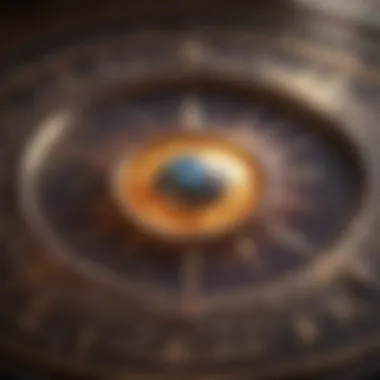Understanding Soulmate Birth Charts: A Deep Dive


Intro
Astrology has been a subject of fascination across cultures for centuries. It invites individuals to reflect on their lives and connections in a new light. The concept of soulmate birth charts provides a unique lens through which to understand romantic relationships. Each person's birth chart is a celestial fingerprint that reveals significant insights about their personality traits and compatibility with others.
In this article, we will delve into the theory behind soulmate birth charts. We aim to provide a thorough exploration of how astrological elements influence relationship dynamics. By examining the individual zodiac signs, their traits, strengths, and weaknesses, we will clarify how each profile interacts within relationships.
Furthermore, we will discuss compatibility insights that apply not only to love but also to friendship and workplace relationships. Astrological events will also be touched upon, focusing on how they shape our personal interactions and emotional landscape. By the end of this article, readers should feel equipped with the knowledge necessary to navigate relationship complexities with a precise understanding of astrological influences.
Zodiac Profiles
Understanding the zodiac profiles enriches our comprehension of individual differences and compatibility. Each sign possesses distinct characteristics that can either enhance or challenge romantic relationships.
Overview of Each Sign
The twelve zodiac signs represent unique energies and motivations. Here is a brief overview:
- Aries: Bold and adventurous, often takes the initiative.
- Taurus: Grounded and reliable, values stability and comfort.
- Gemini: Curious and expressive, thrives on communication.
- Cancer: Nurturing and sensitive, deeply values emotional ties.
- Leo: Confident and charismatic, often seeks admiration.
- Virgo: Analytical and practical, focuses on details and efficiency.
- Libra: Diplomatic and social, prioritizes harmony in relationships.
- Scorpio: Intense and passionate, values depth and loyalty.
- Sagittarius: Free-spirited and adventurous, appreciates independence.
- Capricorn: Disciplined and responsible, seeks achievement and status.
- Aquarius: Innovative and progressive, values uniqueness and freedom.
- Pisces: Empathetic and artistic, sensitive to the emotions of others.
Personality Traits
Each zodiac sign comes with a set of personality traits that define individual behaviors and preferences in relationships:
- Aries: Courageous, impulsive, quick to act.
- Taurus: Stubborn, patient, devoted.
- Gemini: Adaptable, talkative, indecisive at times.
- Cancer: Emotional, protective, sometimes moody.
- Leo: Generous, ambitious, at times self-centered.
- Virgo: Detail-oriented, modest, overly critical.
- Libra: Charming, fair-minded, indecisive.
- Scorpio: Observant, secretive, fiercely loyal.
- Sagittarius: Optimistic, careless, enjoys freedom.
- Capricorn: Practical, cautious, can be pessimistic.
- Aquarius: Intellectual, aloof, values friendship.
- Pisces: Compassionate, intuitive, can be escapist.
Strengths and Weaknesses
Understanding strengths and weaknesses helps in navigating relationship dynamics:
- Aries: Strength: Leadership; Weakness: Impulsiveness.
- Taurus: Strength: Reliability; Weakness: Stubbornness.
- Gemini: Strength: Witty; Weakness: Superficiality.
- Cancer: Strength: Empathy; Weakness: Over-sensitivity.
- Leo: Strength: Warmth; Weakness: Egoism.
- Virgo: Strength: Resourcefulness; Weakness: Perfectionism.
- Libra: Strength: Cooperation; Weakness: Indecision.
- Scorpio: Strength: Determination; Weakness: Jealousy.
- Sagittarius: Strength: Enthusiasm; Weakness: Bluntness.
- Capricorn: Strength: Ambition; Weakness: Rigidity.
- Aquarius: Strength: Originality; Weakness: Detachment.
- Pisces: Strength: Intuition; Weakness: Escapism.
Understanding these profiles allows individuals to see the broader picture of personal interactions.
The subsequent sections will explore compatibility insights and astrological events, providing more depth in understanding soulmate birth charts.
Preface to Soulmate Birth Charts
The exploration of soulmate birth charts is not just an intriguing topic; it serves as a window into understanding the complex relationships shaped by celestial influences. In this article, we aim to dissect how astrological elements can direct one's journey towards finding a soulmate. The significance of this topic lies in its ability to shed light on the intricate dynamics that govern romantic compatibility.
By focusing on specific astrological components, individuals can gain insights that help them navigate their relationships more effectively. The concept of soulmate charts combines personalized astrological readings with the broader framework of synastry, allowing for a more tailored examination of compatibility.
Key considerations in understanding soulmate birth charts include acknowledging how natal charts reflect personal tendencies and how planetary placements at one's time of birth impact interpersonal connections. Furthermore, knowing how to analyze these birth charts can empower individuals in their romantic pursuits, offering them clarity in situations that may feel perplexing or challenging.
"Astrology offers a framework for self-reflection and understanding of interpersonal dynamics."
This article will not only guide readers through the foundational elements of astrology but also illustrate how these aspects directly correlate with relationship compatibility. Building knowledge in this area can foster a deeper appreciation of astrological influences, enabling better decision-making in romantic endeavors.
Defining Soulmate Birth Chart
A soulmate birth chart is essentially a unique astrological blueprint that indicates potential romantic connections. It is derived from the specific positions of celestial bodies at the exact moment and location of an individual's birth. These positions are believed to affect personality traits, emotional responses, and the way individuals interact with others.
In the context of soulmate connections, the soulmate birth chart highlights the celestial alignments that signify stronger compatibility with other individuals. This is not merely about sun signs matching; it involves a more comprehensive review of the entire natal chart, including the placements of the moon, Venus, and Mars.
Understanding a soulmate birth chart provides valuable insights into what one may seek in a partner and what challenges might arise within the relationship. This understanding can serve as a guide for personal growth and relationship harmony.
Astrology and Relationships
The intersection of astrology and relationships is a complex field that offers profound revelations about human interaction. Astrology, as a tool for introspection, helps individuals understand their own motivations and emotional landscapes. When applied to relationships, it can illuminate the compatibility between partners based on their respective charts.
Many enthusiasts of astrology emphasize that knowing one's partner's birth chart can enhance mutual understanding and foster deeper connections. The dynamics of trust, love, and communication all have astrological triggers that can be identified and monitored.
For instance, a person's moon sign often reveals their emotional needs. In relationships, recognizing and addressing these needs can prevent misunderstandings and encourage a more harmonious bond. Similarly, Venus placements can shed light on how individuals express affection and what they prioritize in romantic partnerships.
By studying the astrological drivers behind relational behavior, individuals can equip themselves with knowledge that leads to healthier and more fulfilling relationships.


The Basics of Astrology
Astrology serves as a framework for understanding human behavior and relationships through the positions of celestial bodies at the time of birth. This section aims to explain the key components of astrology and their relevance to soulmate birth charts. Grasping the foundational aspects of astrology can help individuals appreciate how these celestial influences guide romantic compatibility. With this knowledge, one can better navigate the complexities of love and relationships.
Understanding Natal Charts
A natal chart, also known as a birth chart, is a snapshot of the sky at the exact moment of an individual's birth. It illustrates the positions of planets, the Sun, and the Moon in relation to the Earth. Each chart is unique and serves as a blueprint for understanding personality traits, emotional tendencies, and life paths.
The core elements of a natal chart include:
- Planets: Each planet represents different energies and influences in our lives.
- Signs: The zodiac signs provide the characters through which these energies express themselves.
- Houses: The twelve houses are areas of life where these energies manifest.
By understanding how these elements interact, individuals can gain insights into their own responses to relationships and how they connect with potential soulmates.
Planets, Signs, and Houses
Astrology's structure relies on three main components: planets, signs, and houses. Analyzing these elements helps illuminate the complexities of compatibility within relationships.
Planets
Each planet symbolizes specific aspects of human experience:
- Sun: Represents one's essence and identity.
- Moon: Governs emotions and instincts.
- Venus: Influences love and attraction.
- Mars: Shapes desires and assertiveness.
Signs
Zodiac signs impart certain characteristics onto the planets that occupy them at the time of birth. For instance, a person with Venus in Leo may express their affection openly and dramatically, while someone with Venus in Virgo might be more reserved and practical in love.
Houses
Houses divide the natal chart into twelve segments, each linked to a particular life area. For example, the first house relates to self-image, while the seventh house embodies partnerships. Analyzing which planets occupy these houses provides insight into how an individual engages in various aspects of relationships.
The Role of Planetary Placements
Understanding the dynamics of planetary placements is crucial for analyzing soulmate birth charts. Each planet influences specific aspects of personality and behavior, making them central to relationship compatibility. By examining the positions of these celestial bodies at the time of birth, one can gain insight into how individuals express love, form connections, and navigate challenges in relationships.
Astrology enthusiasts often emphasize that these placements offer a map for personal growth and relational dynamics. It's not merely about identifying signs; it includes understanding how the energies of these planets interact with each other.
"Planetary placements act as a lens through which we can look at our relational capabilities and challenges. They reveal our tendencies in love and compatibility."
Importance of the Sun Sign
The Sun sign, often the most recognized component of astrology, serves as the core of a person’s identity. It reflects one's fundamental essence and character traits. In the context of soulmate birth charts, the Sun sign can play a pivotal role in shaping how one approaches love and relationships.
People with the same Sun sign may exhibit shared behaviors. However, nuances appear when individual characteristics and other planetary placements come into play. Recognizing these traits in oneself and potential partners can help individuals understand compatibility on a deeper level.
Key Traits of the Sun Sign:
- Represents core self
- Influences ego and individual desires
- Affects how one expresses affection
An individual's Sun sign can either complement or clash with a partner's sign, which is where the importance of compatibility comes into focus.
Moon Sign Influences
The Moon sign embodies emotions, instincts, and subconscious reactions. It equates to the inner self, highlighting emotional needs in relationships. Understanding the Moon sign is vital for assessing compatibility because it reveals how partners respond to emotional situations and what they truly seek in a partner.
For instance, someone with a Cancer Moon may prioritize emotional security and comfort while one with an Aries Moon might value independence and action. Such differences can either strengthen a bond or create friction if not recognized and appreciated.
Influence of Moon Sign in Relationships:
- Defines emotional responses
- Highlights nurturing styles
- Affects how partners support each other
Awareness of these Moon placements can guide individuals in fostering more supportive and empathetic connections with their partners.


Mars and Venus in Love
Mars and Venus are typically regarded as the planets of love and desire. Mars represents assertiveness and passion, while Venus embodies affection and harmony. The positions of these two planets in a soulmate birth chart can indicate how lovers pursue romance and how they approach relationships.
Mars fuels desire and attraction. Its placement can suggest how one expresses passion and initiative in love. In contrast, Venus guides how one receives love and values companionship. These dynamics are crucial for building lasting romantic connections.
Considerations for Mars and Venus Placements:
- Mars indicates how one approaches desire and conflict
- Venus reveals personal values in love
- Together, they showcase romantic compatibility
Understanding both these planets provides a dual lens through which to evaluate relationship potential. This perspective allows for a more comprehensive analysis of compatibility, addressing both challenges and strengths in love.
In sum, the role of planetary placements adds essential layers to evaluating soulmate birth charts. It's about more than sun signs; it encompasses a nuanced understanding of emotional responses, desires, and personal connections.
Compatibility Analysis in Astrology
Exploring compatibility analysis in astrology is crucial for understanding how birth charts interact in relationships. This section focuses on the specific elements involved in assessing compatibility and the benefits that arise from this analysis. It is essential for individuals seeking to deepen their connections and understand the dynamics of their relationships through celestial insights.
Key Factors for Compatibility
Several key factors play a role in astrological compatibility. Understanding these elements can help individuals discern the strengths and challenges within their relationships:
- Sun Signs: Sun signs represent core identity and ego. They play a significant role in how individuals express themselves and relate to one another.
- Moon Signs: The moon sign reflects emotional responses and inner selves. It often governs experiences like comfort, security, and nurturing in relationships.
- Venus and Mars Placements: Venus governs love and attraction, while Mars influences passion and desire. Analyzing their placements can provide insight into the romantic dynamics within a partnership.
- Aspects Between Planets: The angles formed between planets in each individual's chart reveal how energies interact. Positive aspects can indicate ease, whereas challenging aspects might highlight conflicts that need resolution.
Understanding these factors helps individuals gain clarity about their relationship's potential trajectories and areas requiring attention.
Synastry: Comparing Birth Charts
Synastry is the art of comparing two birth charts to examine relationship compatibility. It allows individuals to identify how their planets interact with each other. This examination can inform couples about both harmonious and challenging aspects in their relationship.
Some important steps involve:
- Overlaying Charts: By placing one chart over another, individuals can see where planets from both charts align. This is significant for understanding shared energies and influences.
- Identifying Significant Aspects: Look for how each person's planets aspect the other's. For instance, a strong Venus-Mars connection can indicate a spark of attraction, while hard aspects can suggest friction that needs addressing.
- Exploring Houses: The house placement of one person’s planets in relation to the other’s chart indicates specific areas of life where interactions may occur, such as love, work, or communication.
Composite Charts Explained
Composite charts present a merged representation of two individuals' birth charts, embodying the relationship itself rather than the individuals alone. This method offers insights into the identity of the relationship.
Features of composite charts include:
- Midpoint Calculation: The midpoints of each planet from both charts reveal the relationship’s shared energies, challenges, and focal points.
- House Placements: Analyzing which houses the composite chart occupies can indicate where the couple will experience their relationship dynamics most intensely.
- Key Aspects Analysis: Like synastry, examining significant aspects within the composite chart can illuminate strengths and challenges inherent in the partnership.
Understanding the composite chart allows relationships to mature by recognizing shared goals and mutual influences.
In summary, compatibility analysis in astrology is a valuable tool for individuals seeking to navigate romantic relationships with depth. By considering planetary placements, aspects, and the interplay of birth charts, one can gain important insights that facilitate stronger, more fulfilling connections.
Practical Steps to Analyze Your Soulmate Chart
Analyzing a soulmate birth chart is significant for anyone looking to understand romantic compatibility through astrology. This examination reveals how your natal chart and that of a potential partner interplay. By understanding these celestial dynamics, individuals can better navigate relationships and identify key attributes that foster deeper connections. Engaging with this subject draws upon the intricacies of astrology, enhancing one’s approach to romantic partnership decisions.
Gathering Birth Information
Each individual’s birth information is foundational to creating an accurate birth chart. This includes the date, time, and place of birth. Accuracy in the details is essential, as even a small discrepancy can lead to significant variances in chart readings. Here are the steps to gather your birth information:
- Date of Birth: This is usually straightforward but ensure it is in the correct format.
- Time of Birth: This might require checking with family members or birth certificates since birth times can vastly affect planetary positions.
- Place of Birth: The geographic location is crucial, as astrology considers the position of celestial bodies relative to the Earth at your birthplace.
Once this data is collected, it can be used with astrology software or websites that generate natal charts, making the analysis process smoother and more precise.
Creating and Reading a Birth Chart
After obtaining the necessary birth information, the next step involves creating the natal chart. Online tools can generate these charts based on detailed personal data. A birth chart maps the relative positions of planets in various houses and signs. Understanding how to read this chart requires familiarity with basic astrological concepts:
- Planets: Each planet affects different aspects of life. The Sun signifies core identity, while the Moon represents emotions.
- Houses: These are divisions within the birth chart that show areas of life impacted by planetary placements.
- Signs: Each planet resides in a zodiac sign, which colors its influence on personality traits and behaviors.


Reading a birth chart also means recognizing aspects or angles formed between planets. These connections provide insights into dynamics between the partners. Understanding how these traits interact enhances comprehension of potential soulmate connections.
Identifying Key Aspects
Once the chart is created, focusing on key aspects is vital for analysis. Aspects determine how planetary energies interact with each other. Here are a few essential components to consider:
- Conjunctions: When planets are close together, their energies blend, creating strong influences.
- Trines: These are harmonious aspects that suggest ease and compatibility in areas corresponding to the planets.
- Squares: Indicating tension, squares can reveal challenges in the relationship that require attention.
- Oppositions: Suggesting balancing acts, oppositions show areas where partners may differ, often leading to growth.
In addition, looking at the relationship between personal planets, such as Venus and Mars, provides insightful context to romantic interactions. Keeping all these details in mind encourages a deeper understanding of how to analyze soulmate compatibility through birth charts, guiding individuals toward fulfilling relationships.
Understanding your soulmate chart can illuminate the path to healthier, more insightful connections.
Challenges in Compatibility Analysis
Understanding the challenges in compatibility analysis is crucial for anyone exploring soulmate birth charts. Despite the allure of astrology, there exist misconceptions that can undermine its value in guiding us through romantic relationships. Engaging with these challenges allows for a more nuanced approach to astrological compatibility, enabling individuals to navigate their personal paths with greater clarity.
Misconceptions about Astrology
Many people hold onto various misconceptions surrounding astrology and its role in relationships. One common belief is that astrological signs dictate absolute compatibility. However, this view oversimplifies the complexity of human relationships. Compatibility is not merely the sum of two sun signs. Factors like the Moon sign, Venus placements, and overall chart dynamics must also be considered.
There is also a tendency to view astrology deterministically. Critics often argue that if one believes in astrology, they may resign themselves to fate. This perspective ignores the interplay of personal agency and astrological influences.
“Astrology is a tool for self-reflection and understanding, not an absolute measure of fate.”
Astrology provides insight into tendencies and patterns, but it does not dictate outcomes. Recognizing this can empower individuals to take charge of their relationships.
The Role of Free Will
Another significant challenge in the analysis of compatibility is understanding the role of free will alongside astrological influences. While the birth chart reveals potential patterns and tendencies, it does not remove the importance of individual choices. Each person has the capacity to act outside their astrological predispositions.
Relationships often involve complex emotions, experience, and growth. Free will enables individuals to choose how they respond to their partner’s traits and behaviors, highlighting the active role one plays in relationship dynamics. The awareness of personal agency can lead to healthier relationships, allowing partners to work through challenges rather than succumb to them.
The Evolution of Relationship Astrology
Astrology continues to evolve. Its application in relationships, particularly through soulmate birth charts, illustrates how this ancient practice adapts and resonates with modern concerns. The evolution sheds light on how individuals seek deeper connections based on astrological insights. Understanding this evolution is essential for grasping current interpretations of relationship compatibility.
Historical Perspectives
The origins of relationship astrology can be traced back to ancient civilizations. Egyptians, Greeks, and Romans utilized celestial movements to uncover insights about people's natures and relationships. For instance, the Greeks believed that planetary placements could indicate personal traits, which could affect romantic partnerships.
In many historical texts, there are references to the synastry method. This is a technique that compares two individuals’ natal charts to discern compatibility levels and dynamics in relationships. Notably, Ptolemy’s “Tetrabiblos” laid foundational ideas about astrological influences on relationships.
Astrologers of ancient times primarily focused on the Sun and Moon signs to analyze compatibility. They believed that these placements offered essential clues about romantic dynamics. As astrology became more sophisticated, other planetary bodies gained significance in this analysis. This shift marked the beginning of more comprehensive relationship astrology.
Modern Interpretations
Today, relationship astrology has transformed significantly. Current practitioners often emphasize the importance of a full natal chart rather than just the Sun signs. This shift reflects a nuanced understanding of how various planetary placements interact within relationships.
Modern interpretations also incorporate the influences of Venus and Mars. The role of these planets is crucial for understanding love and passion dynamics. Venus represents attraction and love while Mars embodies drive and desire. Together, they provide a more holistic view of romantic compatibility.
Many astrologers now encourage individuals to explore composite charts. This technique merges two birth charts to create a unique chart that reflects the relationship's energy. Understanding this modern approach can lead to deeper insights into partnership dynamics.
Ending
The conclusion serves as a pivotal moment in our exploration of soulmate birth charts. In this section, we underscore the importance of understanding how astrological elements can shape romantic compatibility. Soulmate birth charts are not merely tools for love prediction; they are complex maps that reveal insights into relationship dynamics, emotional needs, and personal growth.
Summarizing Key Points
- Understanding Birth Charts: Birth charts provide a unique snapshot of the sky at the moment of birth, showing the positions of planets and their influences. A comprehensive analysis can highlight essential compatibility factors between partners.
- Planetary Influences: Key placements such as the Sun sign, Moon sign, and planets like Venus and Mars play a crucial role in determining individual traits and relational behaviors. Each component interacts uniquely, thus shaping the relationship experience.
- Compatibility Analysis: Concepts such as synastry and composite charts illustrate how two charts interact. These analyses can identify where strengths lie or challenges may arise in a partnership.
Future Directions for Research
Continued research into soulmate birth charts can lead to greater understanding and appreciation of astrology's role in relationships. The following are potential areas of inquiry:
- Integration with Psychological Theories: Exploring intersection between astrology and established psychological concepts may enrich the understanding of compatibility. This could offer a more holistic view of how individual characteristics, shaped by both celestial and earthly factors, influence relationships.
- Cross-Cultural Astrology: Investigating how different cultures interpret soulmate astrology could broaden perspectives and enhance tools available for compatibility analysis.
- Technological Innovations: As technology advances, utilizing software for more detailed and precise astrological readings can open new paths for individuals seeking to understand their soulmate birth charts better.
In summary, our discussion emphasizes that soulmate birth charts are valuable assets in navigating romantic endeavors. With a deeper understanding, individuals can pursue authentic connections, grounded in astrological insights.
"Astrology offers a compelling lens through which to view relationships, emphasizing the intertwined fates of souls guided by cosmic forces."



